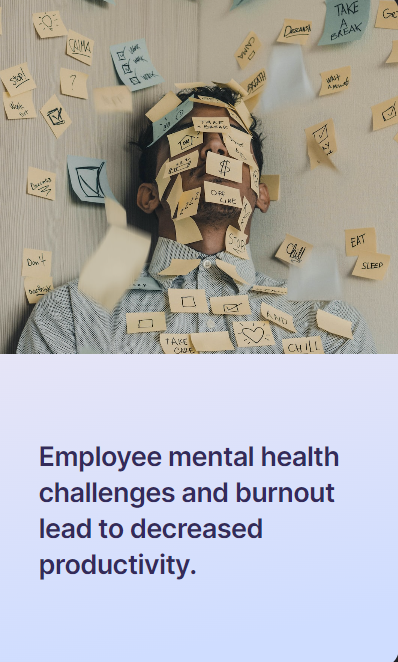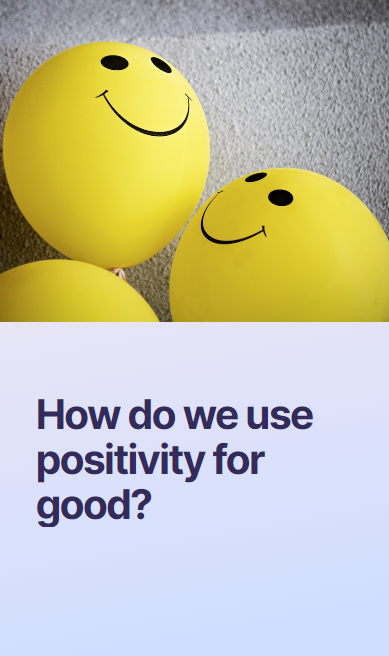This was a 7taps series shared via LinkedIn to great response in the summer of 2022. This topic is designed to help professionals, especially those experiencing challenges due to social media or expectations of unproductive positivity in professional environments. It would also improve workplaces by educating the general populace (workers, managers, workplaces) on how to address problems in a really positive rather than toxic positive way.
Responsibilities: Research, Content Development, Writing/Editing, Instructional Design, eLearning Design & Development (7taps)
Tools Used: 7taps (with a few images edited in Adobe Illustrator and Canva, as well as the included image tools on 7taps)
Date Completed: July 2022
7taps Summer Series: Toxic Positivity
Scroll down to see the 7taps Series.
About the Project
The Project: I began to design and develop it as toxic positivity was a problem people were talking “around” during this time but there was not very much content I was seeing addressing it by name effectively. My goal is always to bring everyone in for consensus, not point fingers. We all engage in toxic positivity — to others and internally — and we all can do better if we are able to name the issue and feeling.
My Skills: This showcases my ability to come up with ideas, address soft skills training/education needs that employees may have, bring awareness to important issues that impact employee experience and employee mental health. It also showcases my ability to design effectively chunked microlearning as a “learning path” (though I don’t have access to 7taps paid learning path feature). It also shows my research skills, as I fully researched this topic through recent articles but also scholarly databases.
View the Toxic Positivity Series Below (7taps Series from Summer 2022)
Introduction to Toxic Positivity
Toxic Positivity in Workplaces
Internalized Toxic Positivity
Tips to Address Toxic Positivity
Only Course 1 is currently available, since I no longer have a 7taps subscription.
Design Process
Analysis Phase (Hypothetical)
Background: Coming out of the pandemic, 6 in 10 Americans suggested Toxic Positivity was still a major issue across sectors (Chiu, 2021). This was true in education sectors, where it was a major complaint from fleeing educators (Alvarez, 2022). It was also true from workers in many sectors, per the Wall Street Journal, becoming a major issue that impacted employee mental health (Bernstein, 2021). There are long-ranging studies going back decades on the power of expressing and accepting negative emotions, both for mental health generally and for workplace productivity (Ford et. al., 2018; Lecompte-Van Poucke; Millacci, 2022).
Learner Profile: This learning solution is made in 7taps for a general audience to use on mobile and find via social media.
Problem/Solution: Toxic positivity remains on the rise and is exacerbated by achievement drive, social media, and factors related to the chaos of the pandemic and the resulting aftermath, to work and life in America and elsewhere. This series serves as a PSA (public service announcement) to support people understanding how to avoid toxic positivity, support themselves and each other, and accept their negative feelings as being okay. The main message is “It’s okay not to be okay” because toxic positivity makes people feel worse for feeling bad in the first place!
Learning Goal: People will be able to identify toxic positivity, reduce the amount of toxic positivity they create for others or themselves, address toxic positivity
Design & Development
This was easy to develop because 7 Taps is such an accessible tool, but I did design additional images with the quotes I had collected. The biggest lift was researching, curating articles and videos, and writing the course, as well as deciding on the topics for the series as a whole.
Images were sourced from:
Canva
Adobe Free Stock
Upsplash (integrated with 7taps)
Giphy (integrated with 7taps)
In the version shown here, any gifs with copyrighted images were removed. Sources and citations were also collected and are shared below.
This was shared via social media on LinkedIn as a series over a month in June/July. It received lots of positive feedback and reshares. It was also shared in the 7taps library, as an associate from 7taps reached out to me to ask permission to share as an example course.
Implementation
Evaluation
Measurement Planning: All I can measure is the number of people who access the course and react (100+ uses and positive reactions so far). Since this is for general public use, it is difficult to measure. Internally, a company conducting trainings on this issue should also pair informational resources like this with in-person workshops, social learning, etc. and could measure for a result based on focus groups, surveys, and observational behavioral change when discussing management. This could be done through the annual review process, if a workplace culture priority.
Credits & Resources
Images in this project were sourced from paid subscriptions to Canva, Unsplash, and Adobe free images.
References
References
Alvarez, B. (2021, January 5). When too much of a good attitude becomes toxic. NEA. Retrieved June 6, 2022, from https://www.nea.org/advocating-for-change/new-from-nea/when-too-much-good-attitude-becomes-toxic
Beck, A., Crain, A. L., Solberg, L. I., Unutzer, J., Glasgow, R. E., Maciosek, M. V., & Whitebird, R. (2011). Severity of depression and magnitude of productivity loss. The Annals of Family Medicine, 9(4), 305–311. https://doi.org/10.1370/afm.1260
Bernstein, E. (2021, November 2). Toxic positivity is very real, and very annoying. The Wall Street Journal. Retrieved June 6, 2022, from https://www.wsj.com/articles/tired-of-being-told-cheer-up-the-problem-of-toxic-positivity-11635858001
Chiu, A. (2020, August 19). Time to ditch 'toxic positivity,' experts say: 'it's okay not to be okay'. The Washington Post. Retrieved June 6, 2022, from https://www.washingtonpost.com/lifestyle/wellness/toxic-positivity-mental-health-covid/2020/08/19/5dff8d16-e0c8-11ea-8181-606e603bb1c4_story.html
Ford, B. Q., Lam, P., John, O. P., & Mauss, I. B. (2018). The psychological health benefits of accepting negative emotions and thoughts: Laboratory, diary, and longitudinal evidence. Journal of Personality and Social Psychology, 115(6), 1075–1092. https://doi.org/10.1037/pspp0000157
Gross, J. J., & Levenson, R. W. (1997). Hiding feelings: The acute effects of inhibiting negative and positive emotion. Journal of Abnormal Psychology, 106(1), 95–103. https://doi.org/10.1037/0021-843x.106.1.95
Kimura, H. (2005). The role of suppression style in producing paradoxical effects of thought suppression. PsycEXTRA Dataset. https://doi.org/10.1037/e633942013-427
Lecompte-Van Poucke, M. (2022). ‘you got this!’: A critical discourse analysis of toxic positivity as a discursive construct on Facebook. Applied Corpus Linguistics, 2(1), 100015. https://doi.org/10.1016/j.acorp.2022.100015
Medical News Today Editorial Team. (n.d.). Toxic positivity: Definition, risks, how to avoid, and more. Medical News Today. Retrieved June 6, 2022, from https://www.medicalnewstoday.com/articles/toxic-positivity#summary
Millacci, T. S. (2022, May 23). Toxic positivity in psychology: How to avoid the positivity trap. PositivePsychology.com. Retrieved June 6, 2022, from https://positivepsychology.com/toxic-positivity-in-psychology/
Sinclair, E., Hart, R., & Lomas, T. (2020). Can positivity be counterproductive when suffering domestic abuse?: A narrative review. International Journal of Wellbeing, 10(1), 26–53. https://doi.org/10.5502/ijw.v10i1.75
Yu, T., & TEDxYouth@CaliforniaHighSchool. (2021). The Problem with Positivity. YouTube. YouTube. Retrieved June 6, 2022, from https://www.youtube.com/watch?v=CH2giVyDjKo.










